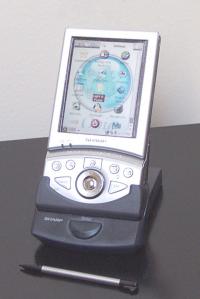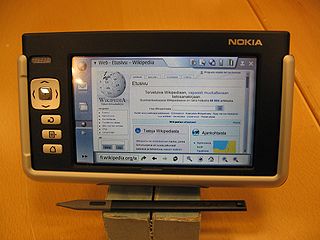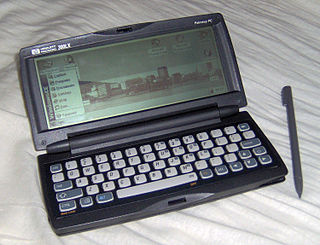
A personal digital assistant (PDA), also known as a handheld PC, is a variety mobile device which functions as a personal information manager. PDAs have been mostly displaced by the widespread adoption of highly capable smartphones, in particular those based on iOS and Android, seeing a rapid decline in use after 2007.

The Sharp Zaurus is the name of a series of personal digital assistants (PDAs) made by Sharp Corporation. The Zaurus was the most popular PDA during the 1990s in Japan and was based on a proprietary operating system. The first Sharp PDA to use the Linux operating system was the SL-5000D, running the Qtopia-based Embedix Plus. The Linux Documentation Project considers the Zaurus series to be "true Linux PDAs" because their manufacturers install Linux-based operating systems on them by default. The name derives from the common suffix applied to the names of dinosaurs.

The xD-Picture Card is an obsolete form of flash memory card, used in digital cameras made by Olympus, Fujifilm, and Kodak during the 2000s. The xD in the xD-Picture Card stands for eXtreme Digital.

The Nokia 770 Internet Tablet is a wireless Internet appliance from Nokia, originally announced at the LinuxWorld Summit in New York City on 25 May 2005. It is designed for wireless Internet browsing and email functions and includes software such as Internet radio, an RSS news reader, ebook reader, image viewer and media players for selected types of media.

The iPAQ Desktop Personal Computer in its various incarnations was a legacy-free PC produced by the Compaq Computer Corporation around the year 2000.
The Sony eVilla was a discontinued Internet appliance from Sony. After 18 months of development, it was released to the public on June 14, 2001 for $499 USD. With the additional $21.95 USD monthly fee, users could access the Internet, send and receive e-mail, play audio and video, and save files to Sony's Memory Stick.
The NSLU2 is a network-attached storage (NAS) device made by Linksys introduced in 2004 and discontinued in 2008. It makes USB flash memory and hard disks accessible over a network using the SMB protocol. It was superseded mainly by the NAS200 and in another sense by the WRT600N and WRT300N/350N which both combine a Wi-Fi router with a storage link.

The i-Opener was a low-cost internet appliance produced by Netpliance between 1999 and 2002. The hardware was sold as a loss leader for a monthly internet service. Because of the low cost of the hardware, it was popular with computer hobbyists, who modified it to run desktop PC software without the internet service.

The Virgin Webplayer is a discontinued Internet appliance from Virgin Group. The device was intended as a standalone Internet access device, running a specialized operating system which limited it to the Virgin Connect ISP. It was discontinued on November 15, 2000. The remaining Webplayer hardware was liquidated and embraced by the hardware hacker community.

The Pepper Pad was a family of Linux-based mobile computers with Internet capability and which doubled as a handheld game console. They also served as a portable multimedia device. The devices used Bluetooth and Wi-Fi technologies for Internet connection. Pepper Pads are now obsolete, unsupported and the parent company has ceased operations.

My Life Online (Mylo) was a device created and marketed by Sony for portable instant messaging and other Internet-based communications, browsing Internet web sites using the Opera web browser and playback and sharing of media files. The pocket-sized, tablet-shaped handheld device, which debuted in 2006, had a screen which slid up to reveal a QWERTY keyboard. The brand name 'Mylo' means My Life Online. Using Wi-Fi instead of cellular networks, the Mylo was targeted to the 18–24 age group.

The Nokia N800 Internet tablet is a wireless Internet appliance from Nokia, originally announced at the Las Vegas CES 2007 Summit in January 2007. N800 allows the user to browse the Internet and communicate using Wi-Fi networks or with mobile phone via Bluetooth. The N800 was developed as the successor to the Nokia 770. It includes FM and Internet radio, an RSS news reader, image viewer and a media player for audio and video files.
The Linutop is a small, light, environmentally friendly Nettop computer containing a metal case and no moving parts, that runs the Linutop OS . Linutop Kiosk software and Linutop Tv server offer a full Digital signage solution. A variety of QT applications oriented towards secure web browsing and digital signage are available in the Operating system. Linutop is multimedia-capable and offers line-out/mic-in for sound. The device can be configured easily into a LTSP thin client. Linutop is suited for use in internet cafés, public libraries and schools.
The Pogo Mobile was a GSM-based mobile device developed by British start-up Pogo Technology Ltd. It combined web browsing, messaging, audio playback and phone functionality in a portable form.

Zonbu was a technology company that markets a computing platform which combines a web-centric service, a small form factor PC, and an open source based software architecture. Zonbu was founded by Alain Rossmann and Gregoire Gentil.

The Nokia N810 Internet tablet is an Internet appliance from Nokia, announced on 17 October 2007 at the Web 2.0 Summit in San Francisco. Despite Nokia's strong association with cellular products, the N810, like preceding tablets produced by Nokia, was not a phone, but instead allowed the user to browse the Internet and communicate using Wi-Fi networks or with a mobile phone via Bluetooth. It built on the hardware and software of the Nokia N800 with some features added and some removed.

The HP 300LX was one of the first handheld PCs designed to run the Windows CE 1.0 operating system from Microsoft. Unlike other HPCs of the time, the resistive touch screen had an enhanced screen resolution of 640x240 with 4 shades of grey, rather than the standard 480x240 resolution of other devices, such as the Casio Cassiopeia A-10. The device also sported a full PC card slot, a serial link cable plug, and an infrared port.

The BeagleBoard is a low-power open-source single-board computer produced by Texas Instruments in association with Digi-Key and Newark element14. The BeagleBoard was also designed with open source software development in mind, and as a way of demonstrating the Texas Instrument's OMAP3530 system-on-a-chip. The board was developed by a small team of engineers as an educational board that could be used in colleges around the world to teach open source hardware and software capabilities. It is also sold to the public under the Creative Commons share-alike license. The board was designed using Cadence OrCAD for schematics and Cadence Allegro for PCB manufacturing; no simulation software was used.
Linksys manufactures a series of network routers. Many models are shipped with Linux-based firmware and can run third-party firmware. The first model to support third-party firmware was the very popular Linksys WRT54G series.
WebUSB is a JavaScript application programming interface (API) specification for securely providing access to USB devices from web pages.














